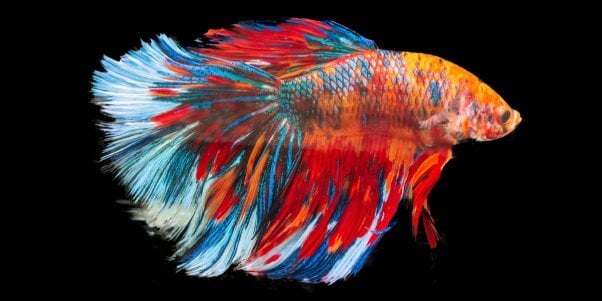How to Introduce Betta Fish to a Community Container Securely
Wiki Article
Breeding Betta Fish: a Comprehensive Step-By-Step Guide to Efficiently Raising Infant Bettas From Eggs to Their Adult Years
Reproducing Betta fish is a thorough undertaking that needs careful preparation and execution to make sure the effective advancement of fry from eggs to develop fish. As the male Betta faithfully constructs a bubble nest and guards the precious eggs, the succeeding phases of care and transition demand interest to detail and knowledge of finest techniques.
Choosing Breeding Pairs
When starting the trip of reproducing Betta fish, selecting the right breeding sets is important to attaining preferable qualities and a healthy and balanced family tree - betta fish. The very first step in this procedure is to identify the specific qualities you want to improve or maintain, such as color, fin type, and body shape. It is important to select genetically varied sets to prevent inbreeding, which can bring about wellness issues and undesirable attributesExamine possible reproducing candidates carefully. A healthy male Betta must show lively colors, an active attitude, and well-formed fins, while the woman ought to likewise display lively coloration and a rounded stubborn belly, indicating preparedness for spawning. Observing the personality of both fish is important, as hostile or overly reluctant individuals might not reproduce effectively.
Maintaining records of the moms and dad fish's ancestry can aid you track hereditary attributes and potential problems. Ultimately, investing time in the choice process will significantly improve the likelihood of generating strong, lively offspring that meet your reproduction objectives.

Preparing the Breeding Tank
Producing an optimal breeding environment is an essential step after choosing ideal pairs for Betta fish. The breeding storage tank need to be especially created to supply comfort and promote the all-natural breeding actions of the fish. Begin with a container size of at least 10 gallons to make certain adequate room for both the male and female Bettas.Keep a mild filtration system to maintain the water tidy while preventing strong currents that can emphasize the fish. Furthermore, an air rock can be included in give oxygenation without interrupting the water surface area excessive.
Temperature level regulation is essential; aim for a secure variety of 78-82 ° F(25-28 ° C) utilizing a trustworthy heating unit. The pH level should be kept between 6.5 and 7.5, and routine water modifications are needed to make certain high water high quality.
Incorporate floating plants or spawning sponges to develop hiding places for the lady, learn this here now while also urging bubble nest building by the male - betta fish. Finally, make sure the container is without sharp designs and any type of possible hazards, as the welfare of Recommended Site the fish must always be focused on during this essential stage of reproduction.
The Breeding Process
Commonly, the reproducing procedure for Betta fish includes a series of distinct and observable actions that indicate readiness for reproduction. The male Betta begins by building a bubble nest at the water's surface, which acts as a site for the fed eggs. This nest is important, as it provides a safe environment for the eggs until they hatch out.As soon as the nest is established, the man will display courtship actions, such as flaring his fins and showing dynamic shades to draw in the female. The lady, upon sensing the male's readiness, will certainly react by presenting upright stripes along her body, signaling her receptiveness.
When the female techniques, the male engages in a mating dance, commonly leading to a welcome recognized as the "spawning." During this accept, the woman releases her eggs, which the male fertilizes instantly. The fertilized eggs after that are up to the bubble nest, where the male meticulously gathers and returns them to the nest. Following this, the male presumes obligation for securing the nest and making sure the security of the eggs until they hatch out, normally within 24-36 hours. This phase is vital in the breeding procedure, laying the structure for effective fry development.
Caring for Betta Fry
Caring for Betta fry needs cautious attention to their environment and nourishment to make certain healthy growth and development. After hatching out, Betta fry are very little and at risk, necessitating a stable and tidy environment.Feeding Betta fry is similarly vital. Feed them small amounts several times a day, Read Full Report being mindful not to overfeed, which can lead to water high quality issues.
Transitioning to Grownup Bettas
As Betta fry mature, transitioning them to grown-up Bettas is an important phase that needs mindful management of their setting and social communications. This process usually begins when the fry get to around six weeks old, whereupon they can be gradually presented to an extra structured living environment.To promote this shift, it is necessary to ensure that the water parameters-- such as temperature, pH, and ammonia levels-- are optimum and secure. Grown-up Betta fish flourish in warm water (around 78-80 ° F) with a pH of 6.5 to 7.5. Gradually adjust the fry to these problems to decrease anxiety.
Social communications are an additional vital variable; male Bettas are infamously territorial and aggressive. Consequently, it is advisable to different men right into specific containers as they develop. Female Bettas can be housed with each other, however treatment needs to be required to keep an eye on for indicators of hostility.
In addition, nutritional modifications must be made as the fry expand. Integrate top notch pellets and live foods to sustain their growth and health and wellness. By managing these aspects successfully, you can promote an effective shift to adulthood for your Betta fish.

Final Thought
Effective breeding of Betta fish calls for careful attention to detail throughout the entire process, from choosing genetically varied pairs to offering optimal care for fry. In addition, a well balanced diet regimen and steady adaptation to grown-up settings are important for the development and advancement of Betta fish.Report this wiki page